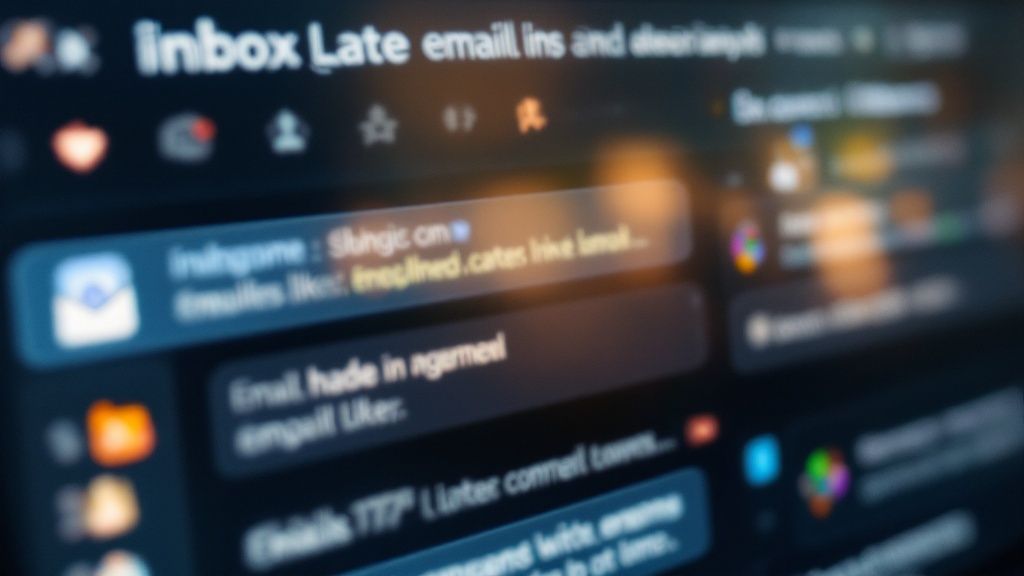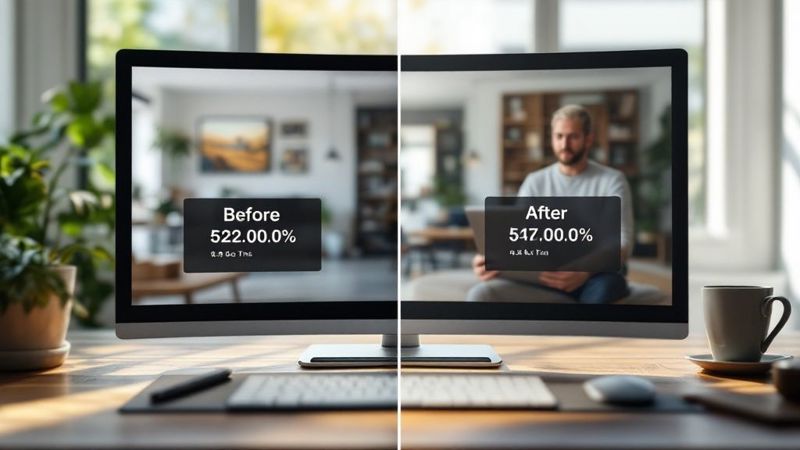Understanding What Drives Modern Email Engagement

Email marketing success starts with getting subscribers to open your messages. But what actually motivates people to click on an email in their crowded inbox? Understanding this is key to creating campaigns that connect with your audience and achieve your business goals.
Beyond the Open Rate: Focusing on True Engagement
Open rates only tell part of the story. When an email gets lots of opens but few clicks or conversions, it signals a mismatch between what the subject line promised and what the email delivered. This means your attention-grabbing headlines might work initially, but the content isn't compelling enough to drive action.
The Psychology of the Inbox: Understanding Recipient Behavior
Think of each email as a knock at your subscriber's door. Your subject line is like a doorbell – it needs to spark interest without being intrusive. Research shows that 47% of people decide whether to open based on the subject line alone. The "From" name matters too – just like checking caller ID, readers are more likely to engage when they recognize and trust the sender.
Setting Realistic Goals and Measuring What Matters
Email performance varies significantly across different fields – some industries see 30% open rates while others average closer to 20%. These differences show why it's essential to set goals that make sense for your specific market and audience. Rather than fixating on opens alone, pay attention to click-throughs, conversions, and unsubscribe rates. Together, these metrics paint a clearer picture of how well your emails connect with readers.
Data-Driven Decisions: A Path to Continuous Improvement
Success comes from testing and learning. Try different subject lines, sending times, and content formats to see what works best. Keep track of which changes lead to better results. This systematic approach helps you move beyond simple open rates to build genuine connections with your subscribers. Each email campaign becomes an opportunity to learn more about your audience's preferences and refine your strategy accordingly.
Crafting Subject Lines That Command Attention

Think of your email subject line like the headline of a newspaper - it needs to grab attention instantly and make people want to read more. Just as you'd carefully choose words for an important conversation, your subject line deserves thoughtful crafting since it often determines whether your email gets opened or ignored.
The Power of Preview Text
The preheader text is your subject line's wingman - those extra words that appear right after the subject in most email apps. This preview gives you bonus space to build interest and provide context. For example, pair a subject line like "Your Special Birthday Surprise Inside" with a preheader that reads "Plus an exclusive gift just for you - open to claim it now!"
Personalization That Resonates
Nobody likes feeling like just another name on a list. That's why personalization matters - but it goes deeper than just adding someone's name. Think about crafting subject lines around what you know about each reader - their past purchases, interests, or behaviors. When you show you understand their needs, they're more likely to pay attention. Learn more about effective email writing in our guide: How to master writing emails that convert.
The Psychology of Scarcity and Urgency
We all hate missing out on good opportunities. That's why creating a sense of scarcity or urgency can be so effective - when used honestly and sparingly. Subject lines like "Only 5 Spots Left for Tomorrow's Workshop" or "Final Day: Member-Only Access Ends at Midnight" tap into this natural response. Just be sure to back up these claims with real limitations to maintain trust.
Finding the Right Length
The numbers tell an interesting story: 47% of people decide to open emails based purely on the subject line. Research shows subject lines between 61-70 characters hit the sweet spot with a 32.1% open rate. When you add a preheader, you can boost click-through rates to 3.12%. And personalized subject lines? They're 26% more likely to get opened. Check out more email statistics here.
A/B Testing: The Key to Optimization
Every audience is unique, which is why A/B testing is so valuable. Try different approaches - maybe one group gets emoji-filled subject lines while another sees straight text. Test various lengths, tones, and personalization methods. Track what works best for your specific readers. This kind of ongoing experimentation helps you fine-tune your approach and steadily improve your results.
Mastering the Science of Perfect Timing

Great subject lines and content are essential, but sending your emails at the right time is just as important for maximizing open rates. Even brilliant emails can get lost in overcrowded inboxes when they arrive at the wrong moment. Let's explore how to find the perfect sending times for your specific audience.
Understanding Time Zones: A Global Perspective
When you have subscribers across different time zones, sending times get more complex. An email that lands at 9 AM for your local readers might reach others at 3 AM - when they're fast asleep. That's why it's crucial to segment your audience by location and use email tools that can automatically adjust delivery times for each zone. This ensures your messages arrive when subscribers are most likely to see them.
Beyond the Basics: Testing and Validation
While there's plenty of advice about "ideal" sending times, what works for one audience may flop with another. Your subscribers have unique habits and preferences. The best approach is to run A/B tests to discover your optimal timing. Try sending identical emails at different times and days, then track which combinations get the most opens.
For instance, you could test morning versus afternoon sends on different weekdays. The data shows that Tuesday tends to perform well, with 27% of marketers preferring it. Average open rates reach 22.0% on Mondays but dip to 20.3% on Sundays, according to research from Mailmunch's email benchmarks. Weekday sends typically outperform weekend delivery.
Balancing Automation with Manual Override
While automated scheduling helps maintain consistency, sometimes you need flexibility. The best approach combines preset schedules with manual control when needed. Set up your regular campaigns to go out automatically, but keep the ability to send time-sensitive announcements right away. This gives you both reliability and responsiveness.
Adapting to Shifting Behaviors
Your audience's email habits change over time as their schedules and priorities shift. What worked last quarter might not work next quarter. Keep a close eye on your timing data and adjust your strategy when patterns change. Regular monitoring helps you spot these shifts early so you can update your sending schedule accordingly. With strategic timing based on real data about your specific subscribers, you'll see more of your emails getting opened and read.
Making Email Personalization Work For You

Basic name personalization no longer makes emails stand out. To improve open rates, marketers need to create truly individualized experiences that speak directly to each recipient's interests and needs. Good personalization makes readers feel understood and valued.
Using Behavior and History Data Effectively
Smart email marketers now combine multiple data points to craft relevant content. They look at what people browse, what they buy, and how they interact with previous emails. For example, if someone frequently looks at running gear on your site, sending them emails about new running shoes or training tips makes more sense than generic promotions. This targeted approach shows readers you understand their interests, making them more likely to open and engage with your emails.
Smart Segmentation That Works at Scale
You don't need to manually personalize every email. Well-designed customer segments let you automatically send relevant content to different groups while maintaining efficiency. The key is identifying meaningful segments based on clear patterns in your data. Want to learn more? Check out: How to master using customer data to drive email marketing success.
Making Every Email Unique with Dynamic Content
Dynamic content lets you customize individual elements within each email. The images, product recommendations, and even the copy can change based on what you know about each reader. This creates an experience that feels tailored just for them, naturally leading to better engagement.
Keeping Automation Personal
While automation helps deliver personalized emails at scale, the human element matters. Skip the robotic language and generic templates. Focus on writing in a natural, conversational tone that connects with readers' real needs and interests. Good personalization should feel authentic, not artificial.
Practical Personalization Ideas
Here are some proven ways to make your emails more personal:
- Local relevance: Include content about events, weather, or news from the reader's area
- Smart suggestions: Show products and content based on their past behavior
- Personal moments: Recognize birthdays, loyalty milestones, and important dates
Using these approaches thoughtfully helps transform standard email blasts into meaningful conversations that readers want to engage with. The goal is simple: make each email feel like it was created specifically for that person. When readers sense that personal connection, they're much more likely to open and act on your emails.
Mastering Technical Deliverability for Maximum Impact
Getting your emails into subscribers' inboxes requires mastering some key technical elements. Without proper technical setup, even the best email content may never reach its intended audience. Let's explore the essential components that help your emails land successfully.
Authentication: Proving Your Identity
Email authentication works like an ID verification system for your messages. Three main protocols help verify that emails truly come from you: SPF (Sender Policy Framework), DKIM (DomainKeys Identified Mail), and DMARC (Domain-based Message Authentication, Reporting & Conformance). Setting these up properly helps email providers trust your messages and improves your chances of reaching the inbox instead of the spam folder.
Maintaining a Healthy Email List: The Importance of List Hygiene
A clean email list is vital for good deliverability. Just like cleaning out your closet, you need to regularly remove inactive subscribers who haven't opened or clicked your emails in months. These dormant addresses can damage your sender reputation over time. By maintaining a healthy list of engaged subscribers, you'll see better performance and fewer spam complaints.
Avoiding Spam Filters: Playing by the Rules
Email providers use sophisticated filters to protect users from unwanted messages. To stay in their good graces, avoid common spam triggers like excessive caps, multiple exclamation points, and pushy sales language. Always include an obvious unsubscribe option - this shows you respect subscriber choices and helps maintain positive relationships with email providers. For more tips on improving engagement, check out How to master click-through rates and email personalization.
Optimizing for Different Email Clients: A Multi-Platform Approach
Your subscribers read emails on many different devices and email programs. Responsive design ensures your messages display properly whether opened on a phone, tablet, or computer. Test your emails across major platforms to confirm they look good and function correctly everywhere.
Monitoring and Troubleshooting: Staying Ahead of Issues
Keep a close eye on your bounce rates - the percentage of emails that fail to deliver. High bounce rates often signal problems with your list quality or technical setup. Pay attention to feedback from email providers about delivery issues. By catching and fixing problems early, you can maintain strong deliverability and keep your email program running smoothly.
Building a Culture of Continuous Optimization
Email marketing success requires ongoing effort and refinement. While implementing good practices is essential, the real magic happens through continuous optimization - systematically testing and improving your campaigns over time, even when they're already performing well.
A/B Testing Beyond the Basics
Most email marketers test subject lines, but there's so much more to explore. Try comparing different email formats - do your subscribers prefer clean, simple text or visually rich HTML designs? Test various call-to-action phrases too. Something as simple as changing "Learn More" to "Get Started" can significantly impact click rates. Remember to test one element at a time to clearly understand what drives results.
Segment-Specific Testing
Your email list contains distinct groups with different needs and preferences. Segment-specific A/B testing helps you uncover these differences. For example, new subscribers might respond better to educational content, while loyal customers prefer exclusive offers. By testing variations within each segment, you can fine-tune your approach for maximum impact across your entire audience.
Interpreting Your Results: Looking Beyond the Numbers
Raw data only tells part of the story - context matters tremendously. A 5% increase in opens from 100 subscribers means less than a 2% boost from 10,000 subscribers. Consider both statistical significance and practical impact when evaluating test results. Small wins with large segments often outweigh bigger gains with tiny audiences.
Prioritizing Your Tests: Focusing on High-Impact Elements
Some email components influence open rates more than others. Focus your testing on elements with the greatest potential impact:
- Subject lines
- "From" names
- Preview text
- Send times
This targeted approach helps you make the most of your testing resources.
Implementing and Iterating: The Cycle of Improvement
When you find a winning variation, roll it out to the relevant segment. But don't stop there - keep monitoring performance and looking for new testing opportunities. Small improvements add up over time, helping your email program get better month after month.
Want to skip the hassle of manually creating personalized images for every subscriber? OKZest automates this process, letting you generate unique, engaging visuals that boost open rates and drive results.